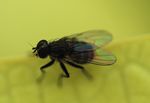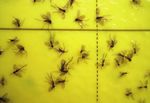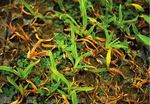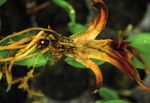Darkwinged Fungus Gnat - HARK Orchideen
←
→
Page content transcription
If your browser does not render page correctly, please read the page content below
Animal pests
Darkwinged Fungus Gnat
ORCHIDEEN
Biology
Darkwinged Fungus Gnat (Sciaridae or Lycoriidae) : Sciara sp., Bradysia sp. Keroplatidae: Orfelia sp. (syn.: Ly-
prauta sp.) are small, 4-6 mm long, black fragile insects. The adult insects fly zigzag over the substrate surface.
The 4-7 mm long larvae are transparent, whitish, slim with a black head capsule. They live in humid substrates
and eat decomposing plant tissue, but big populations can also damage living plants. The darkwinged fungus
gnats often occur in connection with fungus infestation in the thick roots of Phalaenopsis and Paphiopedilum.
Weak plants or plants pre-damaged by harmful fungi are very attractive places to lay their eggs. The larvae are
often imported into the stands in sphagnum. The eggs are small, oval, transparent whitish and lain in humid
substrates. The development from egg to adult takes about 4 weeks. The main species found in greenhouses
are Sciara and Bradysia.
The Orfelia larvae are significantly bigger and slimmer, 15-20 mm long animals have been found in roots. The
adult animals (8-10 mm) are also much bigger than the darkwinged fungus gnats and also markedly differ in
habitus. The back part of the body has horizontal stripes. Most animals of this gnat species all over the world
live on funghi, fungus infested substrates, in moss or under the barks of trees. This may confirm the theory
that the gnat was imported in orchid-breeding companies in substrate containing bark and sphagnum.
Damage
In humid substrates the larvae eat soft roots and as a consequence of that, parasitic root fungi can infest
the plants. If infestation is more severe, the structure of the substrate is destroyed relatively quickly by fine
crumb-like substances. This can be regarded as the real damage on orchids.
Orfelia gnaws in the thick roots of various orchid varieties and in some cases, the stem base is severely dama-
ged, whereas the fine roots remain intact in the initial phase of infestation. Usually, only few larvae are found
in the damaged plants, at times even only one single larva causes the damage. Obvious are also the markedly
visible slime traces on the substrate surface. These insects mainly infest Phalaenopsis and Miltonia, but also
other pot orchids such as Dendrobium, Oncidium or Cambria hybrids.
Control
Greenhouses must be clean and free from wet places with algae and peat. Yellow catchboards can be used
to determine the degree of infestation of Orfelia und Sciara, in addition light traps can be hung up. To check
if any larvae are present, the substrates should be checked for slime traces and the roots of weakly growing
plants should be checked, too. It might also be good to hang up yellow catchboards not only in the plant
stand, but also in the workshop close to artificial lighting and in the substrate storage room.
Biological plant protection
Parasitic nematodes (Steinernema sp., Heterorhabditis sp.): When infestation with Bradysia or Orfelia has
been detected, insect pathogenous nematodes of the Steinernema species and Heterorhabditis can be ap-
plied. The long-time larvae of the nematodes are able to locate harmful larvae and penetrate them through
body openings. By secreting a bacterium, the cell structures in the gnat larvae dissolve. A few days later the
larvae die. This can be seen when parasitised gnat larvae come to the substrate surface and look milky-white.
www.hark-orchideen.de
All statements without guarantee.Animal pests
Darkwinged Fungus Gnat
ORCHIDEEN
Depending on the degree of infestation, 250,000 to 500,000 nematodes per m² are applied on the plants in
water. Applications on spliced young plants are recommended and meristems seem to be slightly more prone
than seedlings. As Orfelia is a relatively big larva, Heterorhabditis are certainly better to use than Steinernema,
they effectively control the gnat larvae that usually occurs in combinations. As it is difficult to find out which
of the larvae really causes the respective damage, combined treatment with both nematode species would be
best.
Insect-pathogenous bacteriae (Bacillus thuringiensis israelensis = B.t.i.): Products with the bacterium B.t.i. are
brought onto the plant by watering. The bacterium forms permanent spores and at the same time protein
crystals (the so-called endotoxin crystals). If these bacterial products are eaten by the sensitive insects, the
crystals destroy the cells of the bowel walls. The bacterium gets into the body, the insects die within a very
short time. B.t.i. is no contact product, but a pure feed poison. After intake of the bacterium, the larvae stop
eating very quickly. The smaller and younger the larvae are the quicker and better the effect of the products
applied. Bti. takes effect only against gnat larvae. Compared to nematodes, bacteriae have a very short life.
Usually, the effect is over after a maximum of one week, so several applications are necessary in case of
infestation. It also has to be considered that they take no effect against adult insects, maggots or eggs, but
only against the larvae that take them in with their food. Due to the relatively high damage potential caused
in orchids by Orfelia, accompanying measures using nematodes or B.t.i. should be carried out on Orchids, until
no more larvae or adult insects are seen.
Predatory mites (Hypoaspis miles, H. aculeifer): Predatory mites are ideal for biological plant protection.
These beneficial insects are very polyphagous, they feed on many different insect larvae and among them also
the larvae of Bradysia. and Sciara. Hypoaspis can reduce the pest when applied regularly and as a prophylactic
to slow down the population growth. They are effective later than nematodes and therefore are not suitable
for direct, quick treatment, but rather as a medium to long-term strategy to control the pest. For this purpose,
about 200-250 animals per m² are spread prophylacticly every 4-6 months in the greenhouse. The predatory
mites are especially effective, when orchid substrates mixed with sphagnum are available. In these conditions
the predatory mites multiply quickly in the greenhouse and even after some months there is still a sufficient
number of them in the stands. As the predatory mites have a comprehensive prey spectrum and eat their prey
in the upper ground layer, those animals can stay in greenhouses for a relatively long time and be active there
up to 6 months in high population densities.
Robber flies (Coenosia attenuata Stein): Coenosia robber flies are predatory species of the Muscidae family.
In many orchid stands these flies settled as spontaneous beneficial animals and have taken over an important
task in the treatment of darkwinged fungus gnats. The robber flies which come from North Africa resemble
our common flies, but they are a bit smaller. They have probably been accidentally imported into greenhouses
in young plants. The adult animals sit still on leaves in the stand and wait for their prey and catch insects fly-
ing by. They open their soft-skinned body parts and suck their prey. Proof of their successful activity is empty
skins of the pests on the upper leaves. In addition to darkwinged fungus gnats they also feed on white flies,
peat flies and leaf-mining flies. The Coenosia larvae are predatory and live in the substrate and among other
insects also feed on the larvae of darkwinged fungus gnats.
www.hark-orchideen.de
All statements without guarantee.Animal pests
Darkwinged Fungus Gnat
ORCHIDEEN
Fungus gnats (Sciara) on yellow adhesive trap UV light trap
Miltonia: Lyprauta at young plants Miltonia: Lyprauta at young plants
Coenosia-robber-fly
© Holger Nennmann www.hark-orchideen.de
All statements without guarantee.Animal pests
Darkwinged Fungus Gnat
ORCHIDEEN
Lyprauta (Orfelia) at yellow boards Lyprauta (Orfelia) larvae
Epidendrum: damage caused by Lyprauta (Orfelia) root damages caused by Lyprauta (Orfelia)
© Hark
www.hark-orchideen.de
All statements without guarantee.You can also read

























































